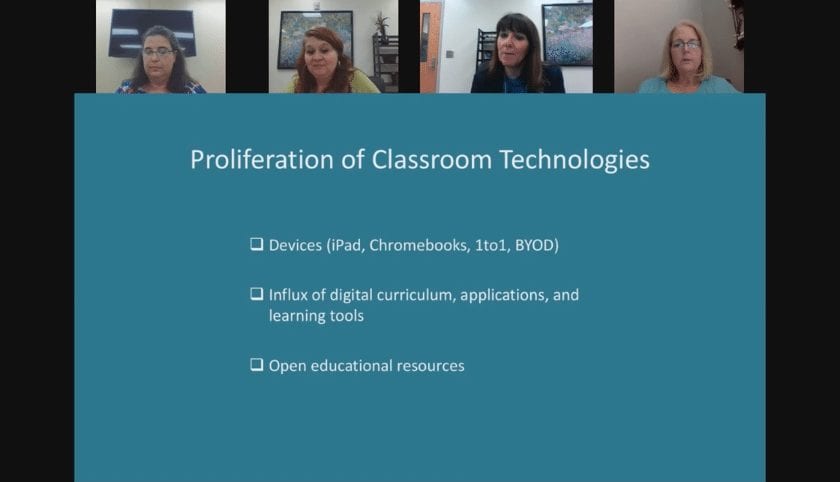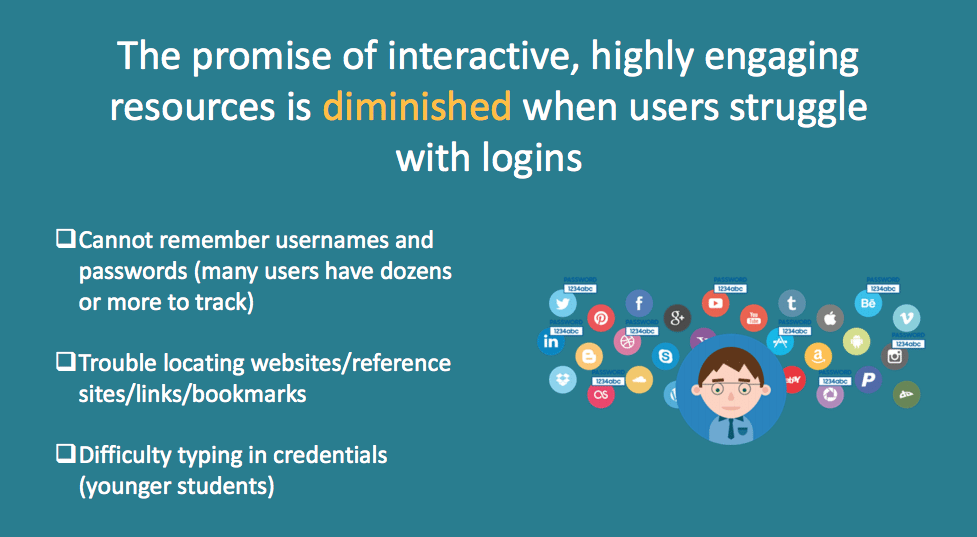Using Single Sign-On to Streamline Edtech Access
Digital educational materials have provided many benefits for K-12 educators and students from computer adaptive assessments to tools that allow students to collaborate and communicate 24/7. At the same time, the myriad of tech programs also have their own set of challenges, particularly when it comes to logging on. For years users have needed to create and memorize a username and password for every system and app. During the edWebinar “Simplify Digital Access in K-12: Learn How District Leaders Eliminate Barriers,” the presenters discussed the importance of adopting a single sign-on program to manage digital access, the questions to ask when choosing a vendor, and tips for rolling out the new system.
First, many programs have different protocols for creating login information, causing students and educators endless frustration. They spend more time in class trying to remember how to access the program than actually using it; they also clog IT channels when passwords aren’t easily recovered. Next, due to the variety of logins, the users end up writing down access information on sticky notes, in notebooks, etc., which compromises security. Or, in order to avoid writing them down, they create basic passwords that are easily hacked. Similarly, without a single sign-on, students may need to memorize multiple URLs and access paths and have difficulty getting to learning resources at home.
Once a district has decided to adopt single sign-on, the administrators vetting the vendors should ask several key questions.
- How strong is the company’s K-12 track record? Will they understand the market’s unique needs and have relationships with other vendors in the industry?
- How big is their library of single sign-on applications? Educators won’t want access to a limited number of tools and instructional resources.
- Do they support multiple login options – ID cards, facial recognition, etc.? This can be important when working with younger students or those with different physical capabilities.
- Do they also support a range of authentication methods, such as LTI or Google? Again, the single sign-on decision should not negatively impact the tools teachers already use.
- Does the vendor support easy access to files from the different applications?
- Does the application deliver class rosters to the different tools?
- What analytics does the program provide? Does it go beyond basic usage?
- Is it customizable? Can schools and districts add colors, logos, etc.?
- What additional features, for example a parent portal, are available?
- What are the vendor’s security and data privacy policies?
Finally, as with all new edtech, a successful rollout depends on having a well-thought-out plan. The presenters emphasized the need for user training—faculty and students—before full implementation, starting with a small portion of the school first, and communicating with students and parents across all avenues about the new system. Most important, schools should celebrate their single sign-on because they will spend less class time on troubleshooting and more on learning.
This broadcast was hosted by edWeb.net and sponsored by ClassLink.
This article was modified and published by eSchool News.
About the Presenters
Dr. Barbara Nesbitt is an educator with over 30 years’ experience. Dr. Nesbitt has been a teacher, instructional and technology coach, consultant, coordinator and director. She is now the executive director of technology for the School District of Pickens County in South Carolina. She earned a B.S. degree in early childhood and elementary education at Liberty University; a Masters of Education in school leadership and policy studies at the University of Virginia; and a PhD in educational leadership at Clemson University. She has served on various boards including the K-12 Institutional Board for IMS Global and the National Council on Digital Convergence. Currently she is the chair of the IMS Global K12 Institutional Board. Dr. Nesbitt lives in Easley, SC with her husband. They have three sons in college.
Jan Mills, VP of Sales for ClassLink, spent 17 years with the Irving ISD as an educator and instructional technology director before leaving to work with various education technology companies. She has a master’s degree in instructional technology and has over 20 years of experience selling and leading sales teams in the K-12 marketplace.
Kimber Nelson is an educator with over 20 years’ experience. Kimber has been a classroom teacher, technology resource teacher, and is now the instructional technology coach for secondary schools for the School District of Pickens County. She earned a B.S. degree in elementary education from Clemson University, is middle level certified, earned a Master’s of Education in educational technology from Nova Southeastern University, and a Master’s of Education in secondary administration and supervision from Anderson University. Kimber lives in Anderson, SC with her husband. They have two children.
Betsy Masters is a 24-year career educator, spending most of those years in the elementary setting. As technology for the classroom becomes more readily available, Betsy has made it her mission to stay abreast of these ever growing and changing trends, while guiding and assisting others along her technology journey. She currently serves as an instructional technology coach for the School District of Pickens County in South Carolina. Betsy has degrees in elementary education from both Clemson University and Southern Wesleyan University. She resides in Six Mile, South Carolina with her husband and two boys.
Join the Community
Technology in Schools is a free professional learning community where district administrators, school leaders, and all educators can share ideas, examples, and resources that relate to integrating technology effectively in schools.






Comments are closed.